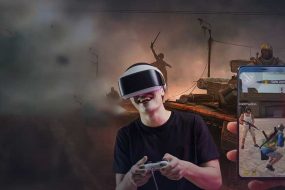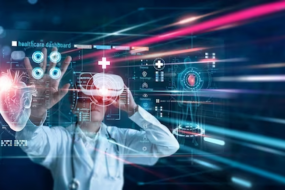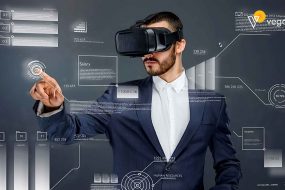
The healthcare sector is undergoing a fast transformation as augmented reality and virtual reality unlock enormous potential to enhance procedures, patient outcomes, and user experiences. AR and VR are being applied creatively throughout the full spectrum of healthcare, from aiding with diagnostics and surgery to improving training and distance care. In this blog, we’ll look at some of the most exciting applications of augmented and virtual reality in the field of healthcare, such as illness diagnosis and prediction, personalized treatment regimens, the development of virtual healthcare assistants, and more. We will examine the existing constraints and difficulties, as well as the potential future applications of these game-changing technologies within the healthcare sector.
Importance of AR and VR in the healthcare industry
Technologies like augmented reality and virtual reality are becoming more and more crucial in the healthcare sector to enhance procedures, training, and patient care. There are a number of ways that AR and VR are changing healthcare and will do so moving forward:
Visualization and training simulation improvements
AR and VR’s immersive 3D visualization capabilities are better than those of conventional monitors and displays. This improves healthcare workers’ training and simulation. For example, VR simulation enables complicated scenario-based training that can lower medical mistakes and enhance abilities.
Improved Visualisation for Accurate Diagnosis and Therapy
A doctor’s perspective of the actual world can have dynamic 3D models, photos, and data superimposed over it using augmented reality. This offers a more comprehensive visualization that can increase the precision of a diagnosis and treatment plan.
Providing Personalised Experiences and Care
A more individualized and customized approach to treatment and patient experiences is made possible by both AR and VR. Patients may more effectively understand and control their health with the help of interactive 3D simulations and virtual assistants.
Enabling Remote Care, Monitoring, and Collaboration
The capabilities of AR and VR devices extend healthcare beyond physical locations by powering things like remote patient monitoring, and virtual visits where experts can provide guidance to colleagues worldwide.
Accelerating Research and Drug Discovery
Immersive environments like VR simulate complex biological systems and allow researchers to interact with and manipulate data in 3D. This can accelerate drug discovery and medical research.
Improving Surgical Outcomes
Augmented reality guidance systems are showing potential to improve surgical accuracy, efficiency, and outcomes through real-time overlays, 3D anatomical views, and assistance for complex procedures.
In all of these ways, augmented and virtual reality technologies are demonstrating the ability to significantly enhance healthcare tasks from training to remote care to diagnosis and treatment. As these technologies mature and integrate into clinical workflows, their importance to the healthcare industry will only continue to grow.
AR Use Cases in Healthcare
Augmented reality is poised to transform the healthcare industry by optimizing processes, improving patient experiences, and enabling more accurate diagnoses and treatments. Augmented reality superimposes digital elements and information onto a user’s view of the real world, enabling an enhanced and more informative experience. When applied to healthcare, AR has the potential to improve outcomes, efficiency, and care quality through a more immersive delivery of visual information and guidance. Several significant applications of AR in medicine include-
Diagnosing and predicting diseases
One major use case for augmented reality in healthcare is improving the accuracy and efficiency of diagnosing and predicting diseases. AR can assist doctors in a variety of ways:
- Overlaying a patient’s medical images directly onto their view of the patient. This allows doctors to see abnormal anatomical features superimposed on the real person, facilitating a more accurate diagnosis.
- Highlighting areas of interest or anomalies within medical imaging scans in real time. This direct visualization helps doctors spot subtle features they may have otherwise missed.
- Providing interactive 3D visualizations of a patient’s anatomy, organs, and conditions. This immersive experience gives doctors a more complete understanding of a patient’s health status to aid in diagnosis.
- Guiding doctors through complex procedures like endoscopies with real-time overlays. AR can visually point out areas to inspect and label abnormalities as they are found.
- Predicting the risk of future diseases by overlaying relevant information onto a patient’s anatomy. For example, AR could visually indicate areas of high plaque buildup to predict stroke risk.
Personalized treatment plans
Another promising application of augmented reality in healthcare is developing and delivering customized treatment plans for patients. Some ways AR can help with personalized treatments include:
- Creating interactive 3D models of a patient’s anatomy, injuries, and conditions to simulate various treatment options. By visualizing different surgical procedures, implants, and therapies overlaid on their 3D model, patients can provide more informed consent.
- Giving patients an AR view of what pre- and post-procedure outcomes may look like for them. For example, visually previewing what a patient’s face may look like after cosmetic surgery. This helps patients set realistic expectations.
- Guiding surgical or interventional procedures with real-time AR overlays that are customized to a patient’s anatomy and condition. For example, overlaying the ideal surgical path for a patient’s specific type of cancer.
- Assisting practitioners and care teams with AR-based checklists, guidelines, and recommendations that are tailored to a patient’s personal health data and history. This ensures procedures follow best practices for that specific patient.
Virtual healthcare assistants
Virtual healthcare assistants can be developed using augmented reality to offer services such as remote monitoring and information access. Following are a few instances of augmented reality-based virtual medical assistants:
- Interactive 3D walkthroughs that demonstrate appropriate form and technique while guiding patients through rehabilitation activities. Patients who get real-time feedback are guaranteed to execute motions properly.
- Virtual practitioners or nurses who communicate with patients via head-mounted displays or smart glasses. They may provide knowledge, respond to inquiries, keep an eye on vital signs, and notify care professionals as necessary.
- Remote monitoring devices that continuously check patients’ symptoms and vital signs using sensors or AR glasses. Alerts to care providers may be generated by any anomalies.
- Personal health avatars serve as virtual coaches for patients, reminding them to take their meds, keeping track of their health objectives, and disseminating knowledge to assist in managing chronic disorders at home.
VR Use Cases in Healthcare
Virtual reality is revolutionizing various aspects of the healthcare industry from training medical professionals and managing patient pain to rehabilitating individuals with conditions that limit motion. VR offers an immersive, interactive, and engaging experience that complements traditional treatments and approaches. Some key applications of VR in healthcare include-
Medical training and education
Virtual reality is also important in training and educating healthcare professionals. Some ways VR is being used for medical training and education include:
- VR simulations provide an immersive training environment that allows medical students and residents to practice procedures and examine virtual patients. They gain experience making diagnoses, treating conditions, and handling emergencies in a safe environment.
- Trainees can encounter complex and rare cases in VR that they may never see in real life. This exposes them to a wide variety of patients and conditions to prepare them for the realities of clinical practice.
- VR medical simulations closely mimic real-life scenarios to test clinicians’ diagnostic and decision-making skills. Trainees are evaluated and receive feedback to correct mistakes before working with real patients.
- Medical educators use VR to demonstrate complicated body structures and systems that are hard to understand conceptually. VR renderings make 3D anatomical relationships and interactions more tangible and easier to learn.
- VR surgical simulations allow trainees to practice specific procedures repeatedly to build skills needed for real operations. They also incorporate haptic feedback to mimic the feel of using actual surgical tools.
Pain management and therapy
Virtual reality is also being used as an effective tool for managing pain and providing therapy for patients. Some ways VR benefits pain management and therapy include:
- VR applications immerse patients experiencing severe acute or chronic pain in relaxing and distracting virtual environments. Patients get absorbed in VR activities that divert their attention away from painful sensations. This provides effective pain relief.
- VR simulations give patients experiencing burn injuries, or wounds, or undergoing painful treatments and rehabilitation a first-person perspective that tricks the mind into ignoring the pain. Patients reported significantly reduced discomfort.
- VR exposure therapy allows patients suffering from phobias, anxiety, and PTSD to gradually confront virtual environments that mimic their fears. In a safe VR space, patients learn to control their reactions and reduce symptoms over time.
- VR systems provide customized virtual environments that guide patients through relaxation and mindfulness exercises to cope with pain. By focusing attention on virtual content, patients achieve a meditative state that lessens pain perception.
- For stroke and accident victims undergoing physical rehabilitation, VR games, and simulations motivate patients to engage in repetitive exercises that hasten recovery. The VR content ensures adherence to therapy regimens.
Rehabilitation and physical therapy
Virtual reality is also being utilized in innovative ways for patient rehabilitation and physical therapy. Some applications of VR in this area include:
- VR games and simulations motivate patients to perform repetitive physical exercises that help improve movement, balance, and coordination as part of their rehabilitation regimens. The interactive VR content ensures patients’ adherence to therapy.
- VR applications allow physical therapists to monitor patients’ movements accurately in 3D space while performing exercises or everyday activities. Therapists can detect issues, provide real-time feedback and adjust treatment plans.
- Stroke and accident victims undergo VR-powered motor skills training to relearn tasks like walking, grasping objects, performing gestures, and articulating words. The VR content engages patients and shortens recovery times.
- VR simulations provide an adaptive environment for patients with neurological conditions to gauge their progress over time. As patients improve, the VR world becomes more challenging to push them further.
- VR systems incorporate haptic feedback to offer resistance during range-of-motion and strengthening exercises. Patients experience a realistic sensation of movement that improves the effectiveness of their rehabilitation.
Conclusion
In summary, while still in their early stages, augmented reality and virtual reality show immense promise to revolutionize how healthcare is practiced through better diagnostics, personalized care, digital assistance, and optimized training. Though challenges exist, when responsibly implemented, these technologies have the potential to alleviate suffering, save lives and push the boundaries of what is possible in medicine. With further advancement and broader access, AR and VR may come to define the future of healthcare.







